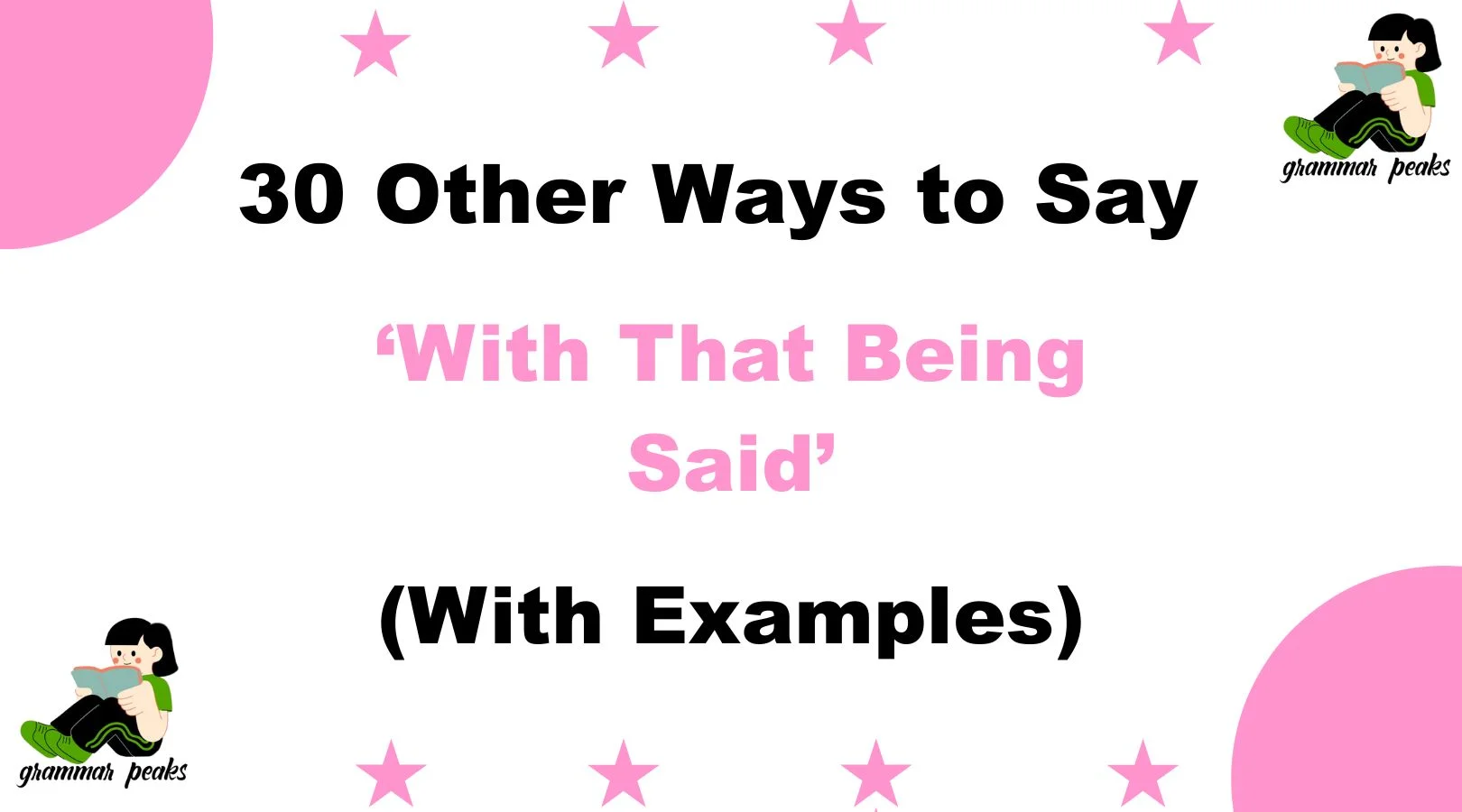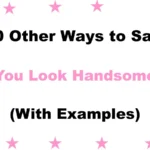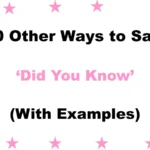Finding the right words to express ourselves with care and clarity can make a world of difference in how our message is received. Sometimes, the phrase “with that being said” feels a bit overused or formal, and you might want something that sounds more personal, warm, or thoughtful.
Using alternatives can help you connect better with your audience, making your communication feel intentional and meaningful. In this article, you’ll discover 30 different ways to say “with that being said”, each with examples, so you can choose the best fit for your unique voice and situation.
What Does “With That Being Said” Mean?
“With that being said” is a commonly used transitional phrase that helps bridge two ideas, often to introduce a new thought that slightly contrasts, adds to, or clarifies what was previously stated. It’s a polite and structured way to signal a shift in conversation, whether you’re softening a disagreement, transitioning to a new point, or offering an additional perspective.
When to Use “With That Being Said”
- When adding a contrasting or qualifying point.
- To gently introduce a caveat or exception.
- To ensure smooth flow in conversations or writing.
Is It Professional/Polite to Say “With That Being Said”?
Yes. It’s professional and polite in most settings, especially in formal writing, presentations, or respectful discussions. However, in casual conversations, alternatives might sound more natural or warm.
Synonyms for “With That Being Said”
Pros:
- Provides clear transitions.
- Signals thoughtfulness and balance.
- Widely understood and accepted.
Cons:
- Can become repetitive if overused.
- May sound stiff or overly formal in casual contexts.
- Sometimes it interrupts flow if not placed carefully.
Synonyms for “With That Being Said”
- Having said that
- That being the case
- All things considered
- On that note
- In light of that
- Considering that
- Given that
- That said
- At the same time
- Nonetheless
- Nevertheless
- Even so
- Despite that
- Still
- Yet
- Be that as it may
- For all that
- In any case
- Regardless
- With this in mind
- Taking that into account
- As a result
- Consequently
- Therefore
- Thus
- So
- To put it another way
- In other words
- To sum up
- To wrap things up
1. Having said that
Definition: A phrase used to introduce a statement that contrasts or softens the previous one.
Explanation: Similar in use to “with that being said,” it signals a shift or additional thought that balances what was just expressed.
Example: “She can be very strict. Having said that, she truly cares about her students.”
Best Use: When you want to acknowledge a different perspective or exception.
Worst Use: Avoid overusing it in quick succession—it can become redundant.
Tone: Friendly, conversational, yet still respectful.
2. That being the case
Definition: Used to indicate that, based on what was just said, the following statement is true or relevant.
Explanation: It ties the next point logically to the previous one, often emphasizing consequence.
Example: “The project is delayed. That being the case, we should adjust our timeline.”
Best Use: In professional or analytical conversations to highlight implications.
Worst Use: May sound too formal for casual talk.
Tone: Formal, clear, and logical.
3. All things considered
Definition: A phrase used to summarize or introduce a conclusion after weighing different factors.
Explanation: It acknowledges complexity before presenting a final thought.
Example: “Traffic was heavy, and the weather was bad. All things considered, we arrived on time.”
Best Use: When drawing a thoughtful conclusion after review.
Worst Use: Not ideal for quick, informal exchanges.
Tone: Reflective, balanced, thoughtful.
4. On that note
Definition: Used to transition smoothly from one topic or idea to a related one.
Explanation: Signals that what follows is connected to the previous point, often wrapping up or moving the conversation forward.
Example: “We’ve discussed the budget cuts. On that note, let’s talk about the new hiring plan.”
Best Use: In meetings or conversations when shifting topics.
Worst Use: Can feel abrupt if used without context.
Tone: Conversational and engaging.
5. In light of that
Definition: Introduces a statement that reflects or responds to the previous information.
Explanation: Suggests that the following idea takes into account recent facts or insights.
Example: “The sales have dropped significantly. In light of that, we should rethink our strategy.”
Best Use: Professional contexts when analyzing or adjusting plans.
Worst Use: Too formal for casual chat.
Tone: Serious, thoughtful, and considerate.
6. Considering that
Definition: A phrase that introduces a point while factoring in the previous statement.
Explanation: Shows you are weighing the prior information before making a statement.
Example: “Considering that it’s her first time, she did very well.”
Best Use: When expressing judgment or opinion gently.
Worst Use: Avoid rapid-fire conversations.
Tone: Empathetic and reflective.
7. Given that
Definition: Introduces a statement based on an accepted fact or condition.
Explanation: Acknowledges a premise before moving on to the related idea.
Example: “Given that the weather is bad, we should reschedule.”
Best Use: When making decisions or suggestions logically.
Worst Use: May feel stiff if overused in casual talks.
Tone: Neutral, logical, and clear.
8. That said
Definition: A concise transition signaling a contrast or qualification.
Explanation: Used to add a statement that balances or counters the previous one.
Example: “I don’t love broccoli. That said, I enjoy it in stir-fry.”
Best Use: In both casual and professional conversations.
Worst Use: Avoid stacking it repeatedly in a paragraph.
Tone: Casual and straightforward.
9. At the same time
Definition: Highlights two points happening simultaneously or balanced together.
Explanation: Indicates that the following thought coexists with or contrasts the previous.
Example: “She’s very busy. At the same time, she makes time for friends.”
Best Use: Showing balance or contrast.
Worst Use: Avoid if timing isn’t relevant.
Tone: Balanced and conversational.
10. Nonetheless
Definition: Means “in spite of that” or “however,” used to introduce a contrasting idea.
Explanation: Expresses resilience or contrast to what came before.
Example: “The test was hard. Nonetheless, I passed.”
Best Use: Formal or semi-formal writing.
Worst Use: Too formal for casual chats.
Tone: Serious, determined.
11. Nevertheless
Definition: Used to introduce a contrasting statement, similar to “nonetheless.”
Explanation: It acknowledges the previous point while presenting an idea that seems to go in another direction.
Example: “He was new to the job. Nevertheless, he handled it like a pro.”
Best Use: When you want to highlight resilience or contradiction.
Worst Use: Too formal for casual chats among friends.
Tone: Professional, respectful, and composed.
12. Even so
Definition: Means “despite what was just said,” offering a contradiction or exception.
Explanation: Softens a contrast while showing that both statements hold value.
Example: “She apologized. Even so, I need time to trust her again.”
Best Use: In thoughtful conversations that weigh emotions or decisions.
Worst Use: Avoid using without clear contrast—it can confuse.
Tone: Gentle, emotional, and reflective.
13. Despite that
Definition: Introduces a statement that occurs in opposition to a prior point.
Explanation: Communicates contradiction in a direct but non-harsh way.
Example: “It rained all day. Despite that, we had fun.”
Best Use: When highlighting perseverance or positive outcomes.
Worst Use: Avoid overuse in rapid transitions.
Tone: Neutral and steady.
14. Still
Definition: A simple way to introduce a mild contradiction or continued concern.
Explanation: Useful for adding nuance or balance to your point.
Example: “The movie had great reviews. Still, I didn’t enjoy it.”
Best Use: Short and effective in casual speech or writing.
Worst Use: Not ideal for very formal documents.
Tone: Conversational, brief, and balanced.
15. Yet
Definition: Similar to “still,” used to introduce contrast or an exception.
Explanation: Emphasizes surprise or contradiction subtly.
Example: “She studied a lot. Yet, she struggled with the exam.”
Best Use: To express disappointment or unexpected outcomes.
Worst Use: Too short for more complex transitions.
Tone: Concise, neutral, and thoughtful.
16. Be that as it may
Definition: An older phrase meaning “regardless” or “even so.”
Explanation: Acknowledges what has been said but introduces a different or more important point.
Example: “He meant well. Be that as it may, his actions caused harm.”
Best Use: Formal speeches or writing where emphasis is needed.
Worst Use: Can sound outdated or overly formal in daily conversation.
Tone: Formal, diplomatic, and reflective.
17. For all that
Definition: Means “despite everything,” offering a contrast or exception.
Explanation: It’s poetic and slightly old-fashioned, often used for emotional impact.
Example: “He was cold and distant. For all that, she still loved him.”
Best Use: Literary writing or emotional conversations.
Worst Use: Avoid in business settings or modern casual talk.
Tone: Romantic, dramatic, and expressive.
18. In any case
Definition: Signals that you’re moving forward, regardless of what was said.
Explanation: Shows the speaker is shifting the focus or resolving a thought.
Example: “It might rain or it might not. In any case, we should bring an umbrella.”
Best Use: To wrap up or refocus a conversation.
Worst Use: May sound dismissive if misused.
Tone: Neutral, efficient, and decisive.
19. Regardless
Definition: Means “without being affected by the previous point.”
Explanation: Often used to push forward with a decision or statement.
Example: “We warned him. Regardless, he took the risk.”
Best Use: When you want to stress determination or decision.
Worst Use: Too abrupt if used without care.
Tone: Strong, confident, and direct.
20. With this in mind
Definition: Used to show that the next idea builds on or considers the previous.
Explanation: Creates a thoughtful transition by reflecting on earlier information.
Example: “Our profits dropped last quarter. With this in mind, we should cut costs.”
Best Use: Strategic discussions or reflective writing.
Worst Use: Avoid light, playful conversations.
Tone: Professional, thoughtful, and strategic.
21. Taking that into account
Definition: Introduces a decision or point that considers earlier facts.
Explanation: Emphasizes thoughtfulness and careful evaluation.
Example: “Taking that into account, we should delay the launch.”
Best Use: Project planning, analytical conversations.
Worst Use: Too wordy for quick chats.
Tone: Measured, analytical, and serious.
22. As a result
Definition: Indicates cause and effect between two statements.
Explanation: Shows logical progression rather than contrast.
Example: “He missed several deadlines. As a result, he lost the client.”
Best Use: In professional reports or analysis.
Worst Use: Avoid if there’s no direct consequence.
Tone: Clear, logical, and factual.
23. Consequently
Definition: A formal version of “as a result.”
Explanation: Often used in academic or professional settings to show outcomes.
Example: “Product demand increased. Consequently, production was doubled.”
Best Use: Formal writing and presentations.
Worst Use: Too stiff for personal conversations.
Tone: Academic, structured, and formal.
24. Therefore
Definition: Shows that something logically follows from what was just said.
Explanation: One of the most straightforward cause-and-effect transitions.
Example: “Customer feedback was poor. Therefore, we changed our approach.”
Best Use: Essays, reports, debates.
Worst Use: Avoid in casual texts—it may sound robotic.
Tone: Professional, logical, and factual.
25. Thus
Definition: A shorter, formal synonym of “therefore.”
Explanation: Used mostly in written communication to express conclusion.
Example: “The experiment failed. Thus, we revised our hypothesis.”
Best Use: Academic or technical writing.
Worst Use: Too formal for speech or social media.
Tone: Polished, formal, and precise.
26. So
Definition: A casual way to show result or continuation.
Explanation: Widely used in everyday conversation and writing.
Example: “I missed the train, so I took a cab.”
Best Use: Informal writing, conversations, and storytelling.
Worst Use: May seem lazy in formal documents.
Tone: Casual, natural, and conversational.
27. To put it another way
Definition: Used to rephrase or clarify a previous statement.
Explanation: Helps make your point clearer or more relatable.
Example: “She was overwhelmed. To put it another way, she was drowning in stress.”
Best Use: When clarifying or simplifying complex ideas.
Worst Use: Repetition without added clarity.
Tone: Helpful, patient, and clear.
28. In other words
Definition: Similar to the above, used to rephrase for better understanding.
Explanation: Simplifies a concept or restates it in a more accessible way.
Example: “The system crashed due to memory overload. In other words, it couldn’t handle too many tasks.”
Best Use: Explanations, teaching, or emphasis.
Worst Use: Avoid when no clarification is needed.
Tone: Clear, informative, and approachable.
29. To sum up
Definition: Signals a summary of the previous discussion.
Explanation: Helps wrap up a point concisely and clearly.
Example: “We’ve explored several strategies. To sum up, we should go with option B.”
Best Use: Closing remarks or reviews.
Worst Use: Don’t use too early in a discussion.
Tone: Concluding, structured, and final.
30. To wrap things up
Definition: A casual way of saying “to conclude.”
Explanation: Signals the end of a conversation or topic with a relaxed tone.
Example: “To wrap things up, I just want to say thank you for being here.”
Best Use: End-of-meeting remarks, speeches, or informal writing.
Worst Use: Avoid in academic or highly formal settings.
Tone: Friendly, informal, and sincere.
Conclusion
Finding the right words doesn’t just change how you communicate—it transforms how people feel when they hear you. Whether you’re writing an email, giving a presentation, or having a heartfelt conversation, using thoughtful alternatives to “with that being said” shows emotional intelligence, intention, and care.
By selecting the transition that matches your tone, audience, and context, you can ensure your message is both clear and compassionate. Keep exploring new expressions—your words have power, and using them mindfully makes all the difference.
FAQs
1. What does “with that being said” mean?
Answer: The phrase “with that being said” is a transitional expression used to introduce a statement that contrasts, qualifies, or builds upon what was just mentioned. It helps connect ideas smoothly and signals that a related or contrasting point is coming.
2. When should I use alternatives to “with that being said”?
Answer: Alternatives are best used when you want to add variety, better match your tone, or clarify your message. Using different phrases can make your communication feel more personal, thoughtful, and appropriate to the situation—whether formal or casual.
3. Are all the alternatives suitable for professional settings?
Answer: Not all alternatives fit every situation. Some, like “nevertheless” or “consequently,” are more formal and professional, while others like “so” or “to wrap things up” are casual and conversational. Choosing the right one depends on your audience and context.
4. Can using the same transitional phrase repeatedly affect my writing?
Answer: Yes. Repeating the same phrase like “with that being said” too often can make your writing sound monotonous or unoriginal. Using varied expressions keeps your writing engaging and helps convey your points more effectively.
5. How can I decide which alternative to use?
Answer: Consider the tone you want to set (formal, casual, reflective), the relationship with your audience, and the purpose of your message. Also, think about whether you’re showing contrast, consequence, clarification, or conclusion, then choose the phrase that best fits that function.

Mia Rose is a passionate Language Coach and Contributor at GrammarPeaks, where she specializes in practical grammar tips and language learning strategies. With a strong foundation in education and communication, Mia brings a friendly, approachable style to her writing. Her goal is to make complex grammar rules simple and usable for learners at any level, helping them grow in both confidence and fluency.





